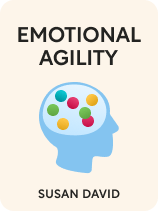

This article is an excerpt from the Shortform book guide to "Emotional Agility" by Susan David. Shortform has the world's best summaries and analyses of books you should be reading.
Like this article? Sign up for a free trial here.
Do you give yourself permission to feel what you feel? Do you allow yourself to struggle and even fail?
Clinical psychologist and management consultant Susan David promotes emotional agility. That means having objectivity about what happens and how you feel and then deliberately responding in a healthy way. Part of emotional agility is accepting your emotions as they are.
Read more to learn about the importance and the process of giving yourself permission to feel.
Accepting Your Emotions
David explains that accepting your emotions means compassionately giving yourself permission to feel, struggle, and fail. You’ll acknowledge that neither the act of feeling unwanted emotions—particularly guilt and shame—nor the act of believing inaccurate narratives make you less of a person.
To achieve acceptance and self-compassion, David encourages you to look at your own faults and flaws as you would those of a loved one or a young child—with forgiveness. This strips away the accusatory power that self-narratives often hold.
In our example of feeling guilty about dropping out of college, you might be telling yourself that failing in the past makes you a failure. Self-compassion in this case might mean saying, “I regret my past decision, but I can still learn from it and make different choices in the future.” You acknowledge your past mistakes without believing the lie that you should feel guilt or shame forever.
David notes that accepting your emotions can help you use them for their evolutionary purpose: prompting behaviors that can improve your life. Regret from dropping out of college might prompt reflection and planning for a return to school or an attempt at moving up in your career—without the fear that you’re a failure who’ll never succeed in new ventures.
| The Importance of Accepting Your Emotions David emphasizes the power of self-compassion, but it may be even more important than she claims. Research suggests that mindfulness and facing your emotions—crucial components of emotional agility—might only be effective for positive mental and physical health outcomes when paired with acceptance. In one study, participants who paid attention to and accepted their emotions reduced their stress hormone and blood pressure levels. Participants who only paid attention to their emotions but didn’t accept them saw a much weaker improvement. Research also shows that exposure to a source of stress (through exposure therapy) is effective for reducing physiological responses to the stressor. This helps your brain understand that the source of stress isn’t actually a physical danger. Similarly, accepting negative emotions and realizing they’re not a threat to you can help you feel less stress when you experience those emotions. |

———End of Preview———
Like what you just read? Read the rest of the world's best book summary and analysis of Susan David's "Emotional Agility" at Shortform.
Here's what you'll find in our full Emotional Agility summary:
- Why most people react instinctively rather than objectively
- How to live according to your values to create the life you want
- How to handle your emotions better using mindfulness techniques






